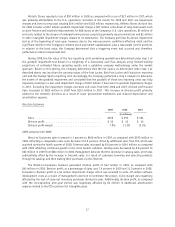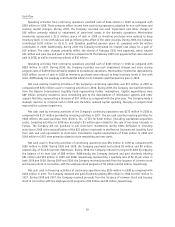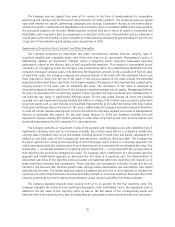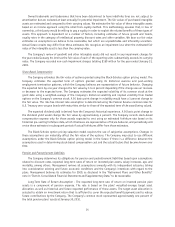Foot Locker 2009 Annual Report Download - page 41
Download and view the complete annual report
Please find page 41 of the 2009 Foot Locker annual report below. You can navigate through the pages in the report by either clicking on the pages listed below, or by using the keyword search tool below to find specific information within the annual report.
The Company receives support from some of its vendors in the form of reimbursements for cooperative
advertising and catalog costs for the launch and promotion of certain products. The reimbursements are agreed
upon with vendors for specific advertising campaigns and catalogs. Cooperative income, to the extent that it
reimburses specific, incremental and identifiable costs incurred to date, is recorded in SG&A in the same period as
the associated expenses are incurred. Reimbursements received that are in excess of specific, incremental and
identifiable costs incurred to date are recognized as a reduction to the cost of merchandise and are reflected in
cost of sales as the merchandise is sold. Cooperative reimbursements amounted to approximately 27 percent and
11 percent of total advertising and catalog costs, respectively, in 2009.
Impairment of Long-Lived Assets, Goodwill and Other Intangibles
The Company recognizes an impairment loss when circumstances indicate that the carrying value of
long-lived tangible and intangible assets with finite lives may not be recoverable. Management’s policy in
determining whether an impairment indicator exists, a triggering event, comprises measurable operating
performance criteria at the division level as well as qualitative measures. If an analysis is necessitated by the
occurrence of a triggering event, the Company uses assumptions, which are predominately identified from the
Company’s three-year strategic plans, in determining the impairment amount. In the calculation of the fair value
of long-lived assets, the Company compares the carrying amount of the asset with the estimated future cash
flows expected to result from the use of the asset. If the carrying amount of the asset exceeds the estimated
expected undiscounted future cash flows, the Company measures the amount of the impairment by comparing the
carrying amount of the asset with its estimated fair value. The estimation of fair value is measured by
discounting expected future cash flows at the Company’s weighted-average cost of capital. Management believes
its policy is reasonable and is consistently applied. Future expected cash flows are based upon estimates that, if
not achieved, may result in significantly different results. For the year ended January 30, 2010, the Company
recorded non-cash impairment charges totaling $36 million. A charge of $32 million was recorded to write-down
long-lived assets such as store fixtures and leasehold improvements, at its Lady Foot Locker, Kids Foot Locker,
Footaction and Champs Sports divisions for 787 stores. Additionally, the Company recorded a charge of $4 million
to write off certain software development costs for the Direct-to-Customers segment as a result of management’s
decision to terminate this project. For the year ended January 31, 2009, the Company recorded non-cash
impairment charges totaling $67 million primarily to write-down long-lived assets, such as store fixtures and
leasehold improvements, for the Company’s U.S. store operations.
The Company performs an impairment review of its goodwill and intangible assets with indefinite lives if
impairment indicators arise and, at a minimum, annually. We consider many factors in evaluating whether the
carrying value of goodwill may not be recoverable, including declines in stock price and market capitalization in
relation to the book value of the Company and macroeconomic conditions affecting retail. The Company has
chosen to perform this review at the beginning of each fiscal year, and it is done in a two-step approach. The
initial step requires that the carrying value of each reporting unit be compared with its estimated fair value. The
second step — to evaluate goodwill of a reporting unit for impairment — is only required if the carrying value of
that reporting unit exceeds its estimated fair value. The Company used a combination of a discounted cash flow
approach and market-based approach to determine the fair value of a reporting unit. The determination of
discounted cash flows of the reporting units and assets and liabilities within the reporting units requires us to
make significant estimates and assumptions. These estimates and assumptions primarily include, but are not
limited to, the discount rate, terminal growth rates, earnings before depreciation and amortization, and capital
expenditures forecasts. The market approach requires judgment and uses one or more methods to compare the
reporting unit with similar businesses, business ownership interests or securities that have been sold. Due to the
inherent uncertainty involved in making these estimates, actual results could differ from those estimates.
The Company assigned discount rates ranging from 12 to 14 percent for the four reporting units. The
Company evaluated the merits of each significant assumption, both individually and in the aggregate, used to
determine the fair value of the reporting units, as well as the fair values of the corresponding assets and
liabilities within the reporting units, and concluded they are reasonable and are consistent with prior valuations.
23
























